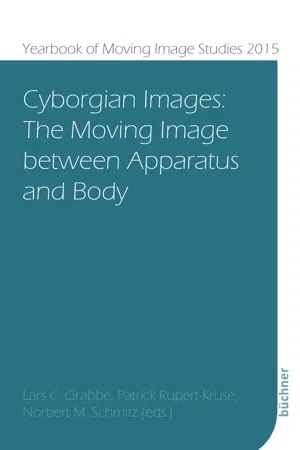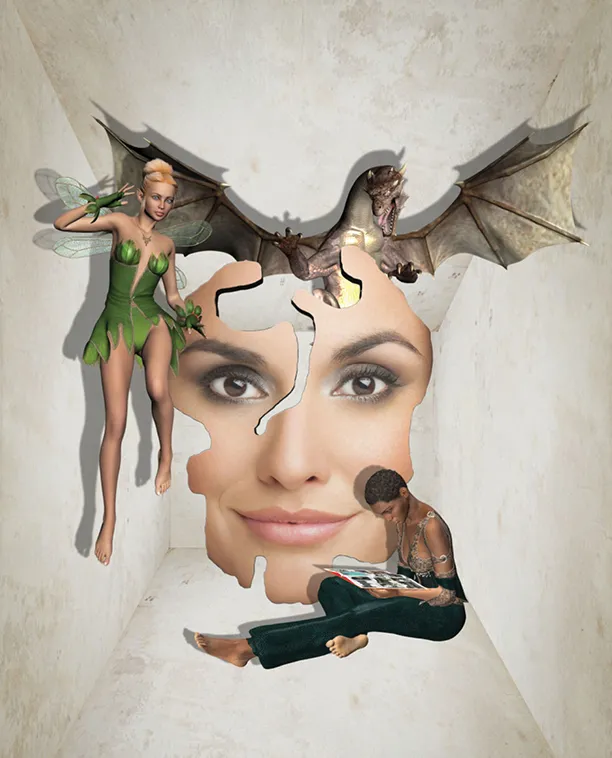
Cyborgian Images
The Moving Image between Apparatus and Body
- 229 pages
- English
- ePUB (mobile friendly)
- Available on iOS & Android
Cyborgian Images
The Moving Image between Apparatus and Body
About this book
One of the big myths and metaphors of the postmodern age is the Cyborg, which includes a large amount of different meanings. The Cyborg often expresses the transformation and extension of the body and exemplifies a postmodern range of technical determinism and human comprehension. In this perspective the Cyborg is no longer a concept of science fiction, technical apocalypse or cyberpunk, but more a construct that highlights the relation of modern media technologies within our every day culture; as well as the body and mind of spectators and users of these media systems.We are connected with a variety of poly-sensual media systems, and we use its potential for communication, multiplying knowledge, spatial and temporal orientation or aesthetic experience. Therefore we are a kind of Cyborgs, connected to media by complex multimodal interfaces.This volume monitors and discusses the relation of postmodern humans and media technologies and therefore refers to Cyborgs, interfaces and apparatuses within the perspective of an autonomous image science.
Frequently asked questions
- Essential is ideal for learners and professionals who enjoy exploring a wide range of subjects. Access the Essential Library with 800,000+ trusted titles and best-sellers across business, personal growth, and the humanities. Includes unlimited reading time and Standard Read Aloud voice.
- Complete: Perfect for advanced learners and researchers needing full, unrestricted access. Unlock 1.4M+ books across hundreds of subjects, including academic and specialized titles. The Complete Plan also includes advanced features like Premium Read Aloud and Research Assistant.
Please note we cannot support devices running on iOS 13 and Android 7 or earlier. Learn more about using the app.
Information
Mirror, Mirror in the Computer Screen: Virtual Bodies and Virtual Worlds as »Becoming« Authentic
»We are what we pretend to be, so we must be careful what we pretend to be« (Kurt Vonnegut in Mother Night, 1961).
Abstract
This essay examines the process of identity construction within Second Life, the longest-running virtual world to date. At the center of discussion is the avatar’s role, when embodied visually, as a participant in the virtual community amidst technological convergence. The avatar cannot be defined in isolation, and is subject to myth, imagery, and social conventions imported in the virtual world and underscored by a strong media presence. The avatar is perceived as a real world extension in Second Life, reflecting the human form and/or spirit at least partially, either consciously or subconsciously, in attempts to create (or escape) meaning in both reality and virtuality. Avatar construction is contextualized and considerably limited by economic constraints as well as prior individual and social experience. Interpretations of those experiences differ among scholars, practitioners, and participants. Considering the themes of Manuel Castells (real virtuality), Howard Rheingold (virtual community) and Sherry Turkle (sociable robots), among others, the author creates a model for understanding how virtual worlds might be conceptualized as authentic transformative agents during identity construction. The author has been a long time active member of Second Life as an educator, content creator, and journalist, and that offers her a unique perspective and perhaps bias toward new technologies and online communication and interaction.
Keywords
Second Life, Linden Lab, avatar, virtual world, virtual community, virtual identity
1.Introduction
The goggles throw a light, smoky haze across his eyes and reflect a distorted wide-angle view of a brilliantly lit boulevard that stretches off into an infinite blackness. This boulevard does not really exist; it is a computer rendered view of an imaginary place (Stephenson 1992, 3).

2.The Author as Virtual Participant
Table of contents
- [Cover and Title]
- Contents
- Acknowledgements
- Lars C. Grabbe, Patrick Rupert-Kruse & Norbert M. Schmitz: Introduction
- Norbert M. Schmitz: The »Biology of the Apparatus of Perception«: The Evolution-Theoretical Conditions of Illusion Media
- Phillip McReynolds: Cyborg Cinema: A Womb with a View
- Lars C. Grabbe: Cyborgian Contact with Content? The Phenosemiotics of Interactive Media Systems
- Marco Cesario & Lena Hopsch: The Body in Digital Space
- Katharina Gsöllpointner: Digital Synesthesia: The Merge of Perceiving and Conceiving
- Phylis Johnson: Mirror, Mirror in the Computer Screen: Virtual Bodies and Virtual Worlds as »Becoming« Authentic
- Gregory Minissale: Becoming-Cyborg
- Jacobus Bracker: Game of Thrones – Game of Meanings: Transmedia Construction of Narrative Meaning and the Life of the Moving Image
- Robert Belton: Critical Cyborgs? Hitchcock and the Hermeneutic Spiral
- Authors
- Notes
- [Imprint]